How to deal with winter damage to shrubs….
Winter damage to plants can take you by surprise.
The real problems aren’t necessarily caused by snow, freezing winds or low temperatures in the depths of winter But you can get significant damage caused by sudden changes in temperature.
In the winter of 2018, South East England had warm, mild weather in early spring followed by a bout of cold, snowy weather that was nicknamed the Beast From the East. Plants died in gardens all over. Or at least they seemed to die.
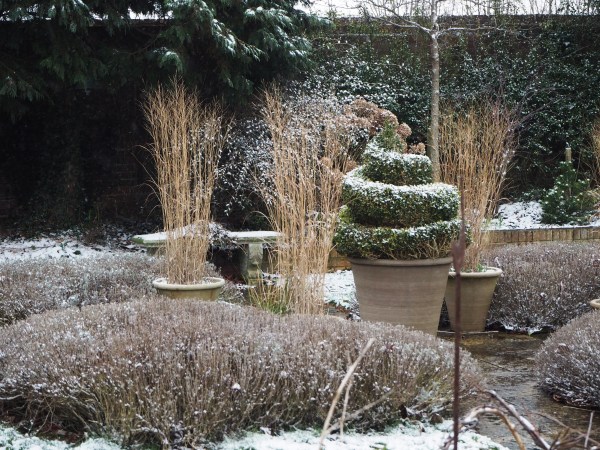
Snow and ice in early March here in the Middlesized Garden. It followed a period of warm weather, when this lavender sent up tiny new shoots.
Lucy Adams, Head Gardener of Doddington Place Gardens, told me that the real issue was the week of warm weather at the beginning of March, just before low temperatures, snow, ice and wind returned. Sap started rising and shrubs started budding.
When the bad weather hit, the plants were much more vulnerable than they would have been a month earlier. ‘The temperature here at Doddington suddenly went down to minus 14 (centigrade),’ she says. It had been around nine or ten degrees the week before.
What does winter damage look like?
My lavender had tiny buds on it. Many of these look burnt. And almost all the leaves have fallen off my privet hedge.
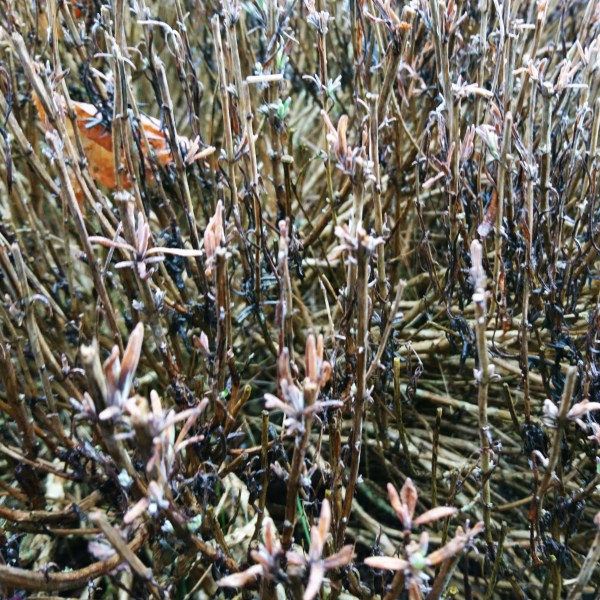
Much of the new growth looks blackened or burnt. But I can see the odd pale blue bud!
So I went to Doddington Place Gardens to ask Lucy what I should do about my winter damage.
‘I’ve never before seen such a wide range of shrubs and trees affected,’ she said. ‘We’ve got leaf drop and scorched leaves on pittosporum, ceanothus, euphorbia, crinodendron, griselinia and eucalyptus.
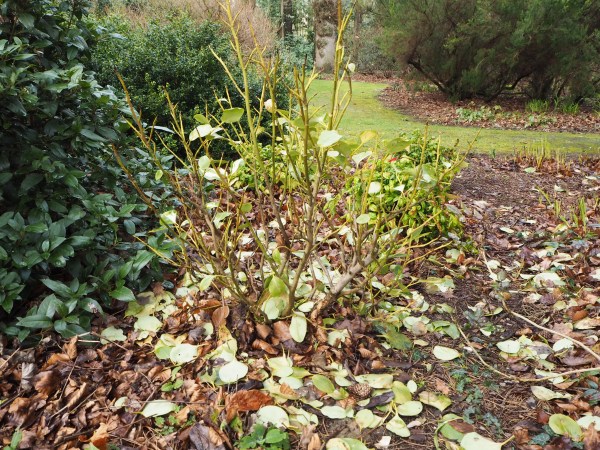
A griselinia affected by winter damage at Doddington Place Gardens
What do about winter damage to shrubs?
Lucy’s advice is to ‘wait and see.’ Patience is the key, because some winter-damaged shrubs will grow back. But there’s not a great deal you can do to encourage them.
She advises you to clear weeds around the roots, so that shrubs aren’t having to compete for nutrition. ‘A layer of mulch will probably help, too.’ She doesn’t think high dosage fertilisers will necessarily help, but a few inches of garden compost, well-rotted manure or mushroom compost is a good idea.
This ‘wait and see’ strategy is an important one.
Harry Baldwin is the Head of Horticulture at Borde Hill Gardens in Kent. He spoke to us about how to save your plants from dying in very hot weather. The problem is that when a plant is under stress, it shuts down to preserve its resources. This leads to dead or dying leaves. It may not lead to the death of a plant.
Whether you’re trying to save your plants from winter damage or summer heat and drought, the message is the same. Cutting a plant back often stimulates growth. If the plant is just hanging on, trying to stay alive in difficult conditions, then asking it to use more energy to grow places it under further stress.
But if you have faith in the resilience of nature, you just leave it alone. The plant is more likely to sort itself out.
Many people dislike seeing dead or dying plants in their garden. If that’s you, then it’s your garden. If you really want to cut the plant back and tidy away the dead leaves, then you are entitled to do so.
The plant may still come back. Cutting it back won’t necessarily kill it, but it will reduce its chances of survival.
Should you cut off winter damaged shoots?
Lucy says that if you prune back the damaged part of the plant, you may shock it too much. ‘Wait until it’s the normal time to prune that plant,’ she advises.
There is a ceanothus at Doddington which has one side burnt by freezing wind, while the other side is fine. Lucy is going to see whether the damaged part will re-grow. She may cut that part back – right down to the ground – but not until she’s waited to see whether it is pushing up new shoots.
So even if there is dead and dying foliage, the best time to prune is when you would normally prune that plant back.
How to tell whether there are signs of life
Lucy is particularly concerned about a very large pittosporum which dominates a border at Doddington.
She doesn’t want to hurry any decision to take it out, although it does look very scorched by the cold. Almost all the leaves look dead. But removing it would leave a very large gap in the border.
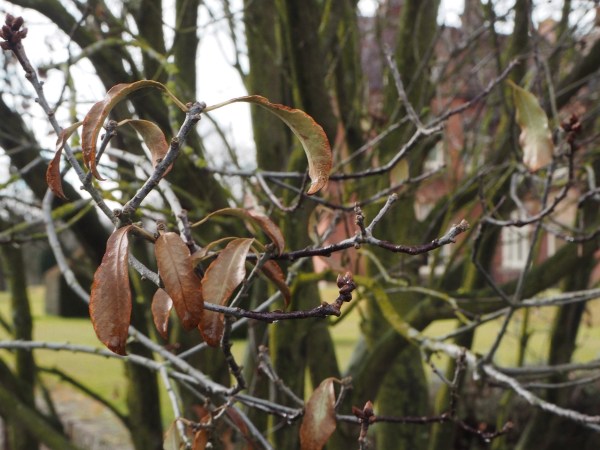
This is a large mature pittosporum that has undoubtedly survived worse winters. Has it survived this one?
So she tries to see if it is still alive with ‘the scratch test’. Scratch away a little bit of bark with your finger or a knife. If there’s green underneath, then the plant is still alive. There is green under the bark of the pittosporum.
You can see Matt Jackson going into more detail about this test here in this video:
Not all plants will survive winter damage
Returning to this post in 2024, I’ve been able to check which plants survived the great freeze in March 2018.
There is a huge old bay tree near me that suffered from winter damage in a major way. Personally, I thought it looked completely dead. But no-one did anything to it. It’s now as big, green and full of leaves.
But not all plants survive. There is a stripey variegated euphorbia at Doddington Place. It’s looking very sick. Lucy doesn’t hold out much hope for it, because variegated euphorbias are more tender than the plain green ones. ‘I’m going to wait and see if it pushes out new growth at its base,’ she says. ‘But if it doesn’t, I’ll take it out.’
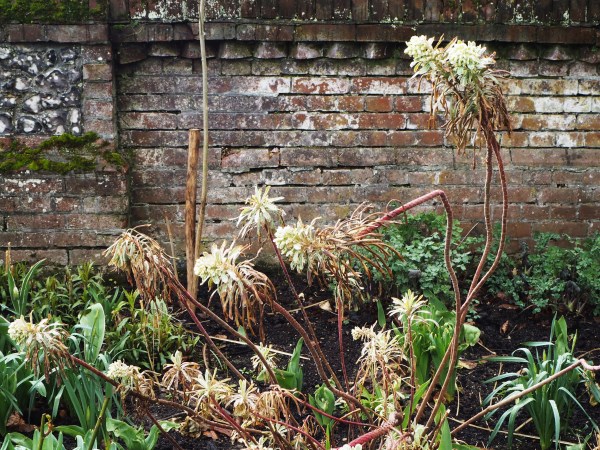
Not a happy euphorbia! Nice garden wall in the background, though.
It’s usually wisest not to plant the same variety of shrub in a spot where a previous one has died.
So I asked Lucy if she’d be able to plant another variegated euphorbia there. ‘A plant that’s died of bad weather probably hasn’t been affected by fungus in the soil,’ she says. ‘So you can usually plant another of the same variety there.’
So to sum up…
‘Just watch and wait.’ That’s my favourite kind of gardening advice. It’s ‘no-effort’ and doesn’t cost anything.

The Millenium obelisk sculpture at Doddington Place with daffodils, out in March and April.
Doddington Place Gardens, near Faversham, Kent, is open to the public on Wednesdays and Saturdays 11am-5pm between 1st of April and 30th of September. And you can read its very interesting garden blog. Finally, here are a few photos to show that most of Doddington Place Gardens has bounced back beautifully.
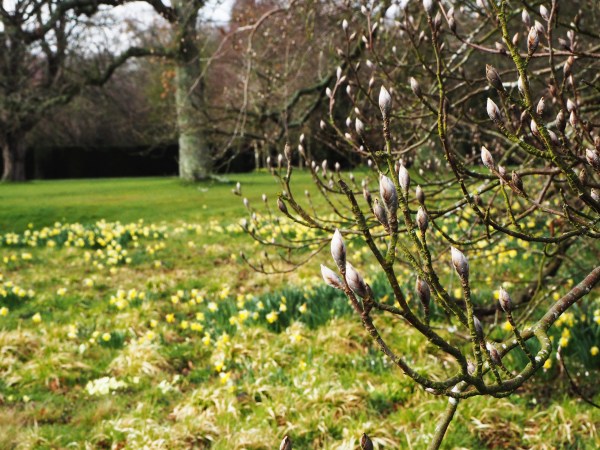
This magnolia seems to be unaffected by any kind of winter damage.

Brooding skies over the romantic Sunk Garden at Doddington Place in late March.
There’s more Doddington Place and an interview with Lucy here in this video:
Pin to remember how to deal with winter damage to shrubs:
And do join us. See here for a free weekly email with more gardening tips, ideas and inspiration.
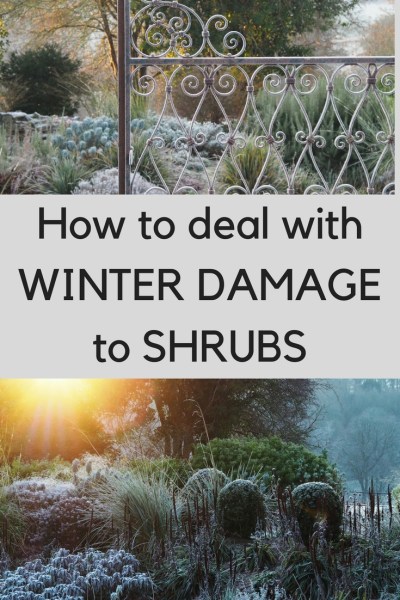
























could you tell me what plants you would fleece to protect against the winter weather thanks dennis bramble
You would generally only have to fleece very tender plants, such as the banana palm (musa basjoo). If you know what the name of a plant is (not necessarily the variant, but the overall name, such as ‘dahlia’ or ‘philadelphus’), you can look up how tender it is on the RHS website. Most plants sold in this country are suitable for our winters, and it’s always a good idea to buy locally grown plants because they will have adapted to the climate. But if you want to grow, for example, an exotic-themed garden, then you may want to include more tender plants, in which case you will either have to fleece them or keep them in pots so that the pots can be brought inside in the winter.
The damage sometimes takes time to appear as well. I initially thought I’d escaped lightly. But it looks like I’ve lost Verbena bonariensis, of which I had three large drifts and used to be perennial here, plus cistus. It feels like a long wait to see what else will fail to produce buds this year. I hadn’t thought to look at the ceanothus. Crinodendron may still be OK. Fingers crossed!
I love drifts of verbena bonariensis, but I’ve often found they don’t come through the winter – maybe a very short-lived perennial? Every morning I peer anxiously at a rose that looks like a scorched stump, and walking the dog round the streets here, I can see so many shrubs burnt by frost or freezing winds on one side. So it will be interesting to see what survives and how – hope your crinodendron survives!
It’s not surprising really. We grow lots of plants from places closer to the equator than here (most of the world!) and often get away with it because of our mild maritime climate. I think you just have to expect to lose some plants every decade or so if you don’t pick plants that evolved to cope with the odd arctic blast.
Unfortunately it seems likely that winters will get harsher ovet coming decades on average. I’m not a climate scientist, but my understanding is that as the arctic warms the jet stream is likely to weaken, with the counterintuitive result that cold air will be more likely to hit the UK in the winter. And the trend to a greater spread in seasonal temperatures would be even greater if the gulf stream shutdown, but most people seem to think that’s a century or two away so we probably don’t have to worry about it.
I agree, I think we ‘get away with it’ as gardeners here in Britain especially in the South and West, so we’re normally very lucky. This winter we weren’t, and maybe other winters to come…but that’s what makes gardening so interesting.
Thank you for this. I started a new Garden from nothing late summer, costly and a lot of hard work. I think I have lost my Phormium and both Cordylines as well as 2 sad looking Pittosporum. My Acacia dealbata looks dead and I am trying to believe that my Musa is only sleeping. I now have a glimmer if hope .
Good luck – I do hope they all survive. My brother-in-law has cordylines in very cold weather, and they seem to survive quite well.
Hi Carole. Can I ask how did your Acacia Dealbata get on? Was it dead or did it survive? I planted one last August. Now it is stripped bare at the bottomtwo-thirds and the top has “foilage” which is curled up…I am thinking of pruninf it down to one third to see if will regenerate stronger. I live by the sea in the South of Ireland and unfortunately my garden is very windy. Maybe I should give up on it…